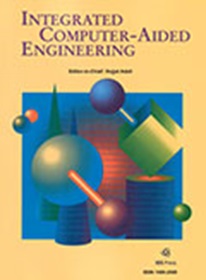Multi-agent simulation of autonomous industrial vehicle fleets: Towards dynamic task allocation in V2X cooperation mode
IF 5.3
2区 计算机科学
Q1 COMPUTER SCIENCE, ARTIFICIAL INTELLIGENCE
引用次数: 0
Abstract
The smart factory leads to a strong digitalization of industrial processes and continuous communication between the systems integrated into the production, storage, and supply chains. One of the research areas in Industry 4.0 is the possibility of using autonomous and/or intelligent industrial vehicles. The optimization of the management of the tasks allocated to these vehicles with adaptive behaviours, as well as the increase in vehicle-to-everything communications (V2X) make it possible to develop collective and adaptive intelligence for these vehicles, often grouped in fleets. Task allocation and scheduling are often managed centrally. The requirements for flexibility, robustness, and scalability lead to the consideration of decentralized mechanisms to react to unexpected situations. However, before being definitively adopted, decentralization must first be modelled and then simulated. Thus, we use a multi-agent simulation to test the proposed dynamic task (re)allocation process. A set of problematic situations for the circulation of autonomous industrial vehicles in areas such as smart warehouses (obstacles, breakdowns, etc.) has been identified. These problematic situations could disrupt or harm the successful completion of the process of dynamic (re)allocation of tasks. We have therefore defined scenarios involving them in order to demonstrate through simulation that the process remains reliable. The simulation of new problematic situations also allows us to extend the potential of this process, which we discuss at the end of the article.自主工业车队的多代理模拟:实现 V2X 合作模式下的动态任务分配
智能工厂实现了工业流程的高度数字化,以及集成到生产、存储和供应链中的各系统之间的持续通信。工业 4.0 的研究领域之一是使用自动和/或智能工业车辆的可能性。对分配给这些具有自适应行为的车辆的任务进行优化管理,以及增加车对万物通信(V2X),使得为这些车辆(通常以车队为单位)开发集体和自适应智能成为可能。任务分配和调度通常由中央管理。由于对灵活性、稳健性和可扩展性的要求,人们开始考虑采用分散机制来应对突发情况。然而,在明确采用分散机制之前,必须首先对其进行建模和模拟。因此,我们使用多代理模拟来测试建议的动态任务(重新)分配流程。在智能仓库等区域,自动驾驶工业车辆的流通遇到了一系列问题(障碍、故障等)。这些问题情况可能会干扰或损害任务动态(重新)分配过程的顺利完成。因此,我们定义了涉及这些问题的情景,以便通过模拟来证明该流程的可靠性。通过模拟新的问题情况,我们还可以扩展这一过程的潜力,我们将在文章末尾对此进行讨论。
本文章由计算机程序翻译,如有差异,请以英文原文为准。
求助全文
约1分钟内获得全文
求助全文
来源期刊

Integrated Computer-Aided Engineering
工程技术-工程:综合
CiteScore
9.90
自引率
21.50%
发文量
21
审稿时长
>12 weeks
期刊介绍:
Integrated Computer-Aided Engineering (ICAE) was founded in 1993. "Based on the premise that interdisciplinary thinking and synergistic collaboration of disciplines can solve complex problems, open new frontiers, and lead to true innovations and breakthroughs, the cornerstone of industrial competitiveness and advancement of the society" as noted in the inaugural issue of the journal.
The focus of ICAE is the integration of leading edge and emerging computer and information technologies for innovative solution of engineering problems. The journal fosters interdisciplinary research and presents a unique forum for innovative computer-aided engineering. It also publishes novel industrial applications of CAE, thus helping to bring new computational paradigms from research labs and classrooms to reality. Areas covered by the journal include (but are not limited to) artificial intelligence, advanced signal processing, biologically inspired computing, cognitive modeling, concurrent engineering, database management, distributed computing, evolutionary computing, fuzzy logic, genetic algorithms, geometric modeling, intelligent and adaptive systems, internet-based technologies, knowledge discovery and engineering, machine learning, mechatronics, mobile computing, multimedia technologies, networking, neural network computing, object-oriented systems, optimization and search, parallel processing, robotics virtual reality, and visualization techniques.
 求助内容:
求助内容: 应助结果提醒方式:
应助结果提醒方式:


